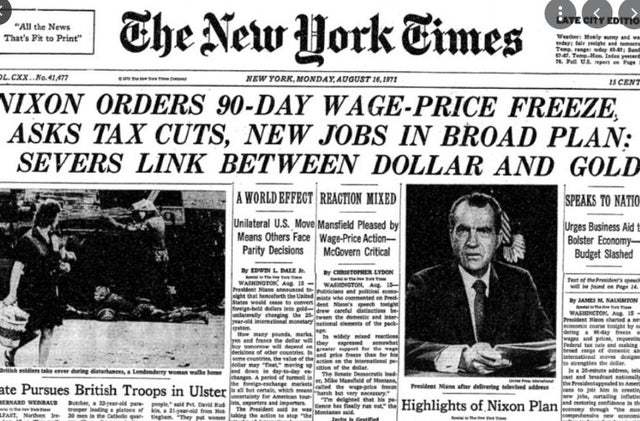


By Steve Sailer
01/09/2016
In puzzling over Merkel’s Boner, I’m reminded of one of the wackier political events of my lifetime: President Nixon imposing a wage and price freeze on the country in 1971. It sounds ridiculous now, but it seemed like a good idea at the time. As I recall, pretty much everybody except Milton Friedman was for it. I was for it. (In my defense, I was 12.)
From The Commanding Heights by Daniel Yergin and Joseph Stanislaw, 1997:
The climax came on August 13-15, 1971, when Nixon and 15 advisors repaired to the presidential mountain retreat at Camp David. Out of this conclave came the New Economic Policy, which would temporarily — for a 90-day period — freeze wages and prices to check inflation. That would, it was thought, solve the inflation-employment dilemma, for such controls would allow the administration to pursue a more expansive fiscal policy — stimulating employment in time for the 1972 presidential election without stoking inflation. The gold window was to be closed. …
Most of the participants at the Camp David meeting were exhilarated by all the great decisions they had made. During their discussions, much attention was given to the presentation of the new policy, particularly to television. President Nixon expressed grave concern that if he gave his speech during prime time on Sunday, he would preempt the tremendously popular television series Bonanza, thus potentially alienating those addicted to the adventures of the Cartwright family on the Ponderosa ranch. But his advisors convinced him that the speech had to be given before the markets opened on Monday morning, and that meant prime time. A few of the advisors would recollect that more time was spent discussing the timing of the speech than how the economic program would work. Indeed, there was virtually no discussion of what would happen after the initial 90-day freeze or how the new system would be terminated. Nixon’s chief of staff, H.R. Haldeman, went in to see the president privately at Camp David the evening before his speech. “The P. was down in his study with the lights off and the fire going in the fireplace, even though it was a hot night out,” Haldeman wrote in his diary. “He was in one of his sort of mystic moods.”
Haldeman’s phrase “mystic moods” doesn’t necessarily mean “drunk.”
Nixon told Haldeman “that this is where he made all his big cogitations…. He said what really matters here is the same thing as did with [Franklin] Roosevelt, we need to raise the spirit of the country; that will be the thrust of the rhetoric of the speech…. We’ve got to change the spirit, and then the economy could take off like hell.” As he worked on the speech, Nixon tormented himself, worrying whether the headlines would read NIXON ACTS BOLDLY or NIXON CHANGES MIND. “Having talked until recently about the evils of wage and price controls,” Nixon later wrote, “I knew I had opened myself to the charge that I had either betrayed my own principles or concealed my real intentions.” But Nixon was nothing if not a practical politician, as he made clear in his masterful explanation of his shift. “Philosophically, however, I was still against wage-price controls, even though I was convinced that the objective reality of the economic situation forced me to impose them.”
Nixon’s speech — despite the preemption of Bonanza — was a great hit. The public felt that the government was coming to its defense against the price gougers. The international speculators had been dealt a deadly blow. During the next evening’s newscasts, 90 percent of the coverage was devoted to Nixon’s new policy. The coverage was favorable. And the Dow Jones Industrial Average registered a 32.9-point gain — the largest one-day increase up to then. The Cost of Living Council took up the job of running the controls. After the initial ninety days, the controls were gradually relaxed and the system seemed to be working. But unemployment was not declining, and the administration launched a more expansionary policy. Nixon won reelection in 1972. In the months that followed, inflation began to pick up again in response to a variety of forces — domestic wage-and-price pressures, a synchronized international economic boom, crop failures in the Soviet Union, and increases in the price of oil, even prior to the Arab oil embargo.
Nixon, under increasing political pressure from the investigations of the Watergate break-in, reluctantly reimposed a freeze in June 1973. Government officials were now in the business of setting prices and wages. This time, however, it was apparent that the control system was not working. Ranchers stopped shipping their cattle to the market, farmers drowned their chickens, and consumers emptied the shelves of supermarkets. Nixon took some comfort from a side benefit that George Shultz, at the time head of the Office of Management and Budget, identified. “At least,” Shultz told the president, “we have now convinced everyone else of the rightness of our original position that wage-price controls are not the answer.” Most of the system was finally abolished in April 1974, 17 months after Nixon’s triumphant reelection victory over George McGovern — and four months before Nixon resigned as president.
So it is possible for the political system to learn from politician’s mistakes. But humiliating loss of office helps get the message across.